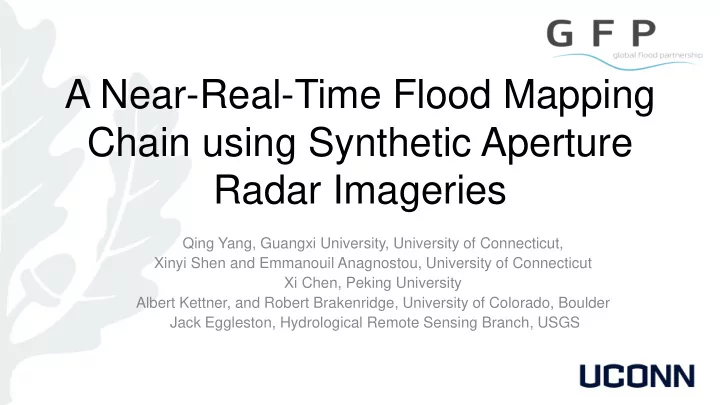

A Near-Real-Time Flood Mapping Chain using Synthetic Aperture Radar Imageries Qing Yang, Guangxi University, University of Connecticut, Xinyi Shen and Emmanouil Anagnostou, University of Connecticut Xi Chen, Peking University Albert Kettner, and Robert Brakenridge, University of Colorado, Boulder Jack Eggleston, Hydrological Remote Sensing Branch, USGS
SAR Data Frequency During Recent Events Sentinel Revisits Sentinel Revisits • Sentinel-1 ( 2014 ) Sept. 10-Nov. 2, 2017 Aug. 27-Sept. 10,2017 – 8 days interval – 2-3 days potential – 10 m spatial resolution • NISAR (2020) – 4 times per month – 5-10 m Shen, et al., (2019). Remote Sensing
The RAdar Produced Inundation Diary (RAPID)-System Overview Flood- Retrieval SAR data Retrieval Algorithm Query Trigger Execution
The Flood Trigger • Daily Flood status of ~4000 stations – USGS Water Watch • Drainage regions – Watershed algorithm- • Potential Flooded Area – Flooded-unflooded
Shen, et al., (2019). Remote Sensing of Environment Overview of the RAdar Produced Inundation Diary(RAPID) 𝑞 𝐽 1 , 𝐽 2 → ℎ 𝐽 1 , 𝐽 2 A B • Water source tracing ∆𝐽 1 ∆𝐽 2 Binary Morphologic (WST) classification processing • Improved change detection (ICD) Theoretical PDF Real PDF 12 x 10 10 10 6 20 20 5 30 30 40 40 C 4 50 D 50 Multi-threshold 3 60 60 Machine compensation 70 70 2 learning-based 80 80 1 refinement 90 90 100 100 0 20 40 60 80 100 20 40 60 80 100
Input Datasets Dataset Name Source/Type Producer Time span Coverage Spatial Res. Revisiting intervals Sentinel-1 SAR ESA Since 2014 Global 3.5/10 m 12 days (after 2013 Oct) 6 days (after 2015 Oct) NLCD Landsat/LCC USGS 1992-2011 US 30 m 5 years GLR-FROM Landsat/LCC Tsinghua Unvi. 2010, 2015 Global 30 m 5 years Water Occurance Landsat/water Pekel et al. 1984-2015 Global 30 m static probability Hydrography NHD-HR USGS N/A US 30 m static DEM STRM USGS N/A Global 10 m US static 30 m global NARWidth TM/River Width George Allen N/A North 30 m static et al. America GWD-LR STRM/River Width & Dai Yamazaki N/A Global 90 m static Hydrograph et al. HydroLakes STRM WWF N/A Global 90 m static US-Detailed Survey USGS/USEPA/E N/A US 10 m static Stream Body SRI
Case study-Typhoon Nepartak, July 17, 2016 Yangtze River, China
Case study-Oct. 10, 2017, Vietnam
Case Study- Hurricane Harvey, Aug. 27-Sept. 10, 2017 https://floodobservatory.colorado.edu/E vents/2017USA4510/2017USA4510.html DFO Comprehensive Map RAPID Map Aug. 30, 2017 Confusion Reference User Matrix accuracy Wet Dry Retrieval Wet 11.09% 3.29% 77% Dry 3.73% 81.90% Producer 75% 93% Aug. 27-Sept. 10, 2017 accuracy
Case Study- Hurricane Florence Sept. 18, 2018
Case Study- Hurricane Florence Sept. 19, 2018
2019 Midwestern U.S. floods
Summary • An automated open-flood Next mapping chain has been • Synergizing active/passive mapped microwave data • Quantitative validation shows • Wetlands/Vegetation flood satisfactory mapping by SAR • It has been tested over many • Base flow estimation events
Combining the Active and Passive Inundation Mapping M/C Flood Scan April 16, 2008
Inundation mapping beneath vegetation • Backscatter enhancement-4a & 4b • Freeman-Durden 3-component Model 𝑇 𝐼𝐼 2 ∗ 0 𝑇 𝐼𝐼 𝑇 𝑊𝑊 2 𝑇 𝐼𝑊 2 0 0 ∗ 𝑇 𝑊𝑊 2 𝑇 𝑊𝑊 𝑇 𝐼𝐼 0 𝐸 𝛽 2 + 3 𝐸 𝛽 + 𝑔 𝑇 𝛾 2 + 𝑔 𝑊 𝑔 8 𝑔 0 𝑔 𝑇 𝛾 + 𝑔 𝑊 8 2 = 0 8 𝑔 0 𝑊 𝐸 𝛽 ∗ + 𝑔 𝐸 + 3 𝑇 𝛾 ∗ + 𝑔 𝑊 𝑔 0 𝑔 𝑇 + 𝑔 8 𝑔 𝑊 8
Inundation beneath Vegetation Detection • Temporal Calibration 𝑑 21 𝜏 𝑟𝑞 0 𝜏 𝑟𝑞 𝑢 2 = 𝑔 𝑢 2 𝑟𝑞 • Incomplete polarimetric decomposition 𝑑 = σ 𝐼𝐼 𝑑 𝑑 𝜏 𝑇𝐸 − 3σ 𝐼𝑊 • Wetland Signature Open Water c σ SD c σ SD c σ HV c σ HV Dry Lands Wetlands c σ SD c σ HV
Acknowledgement • John W. Jones, Hydrologic Remote Sensing Branch, USGS • David M. Bjerklie, New England Water Science Center, USGS • John F. Galantowicz, Atmospheric and Environmental Research, Boston
Recommend
More recommend